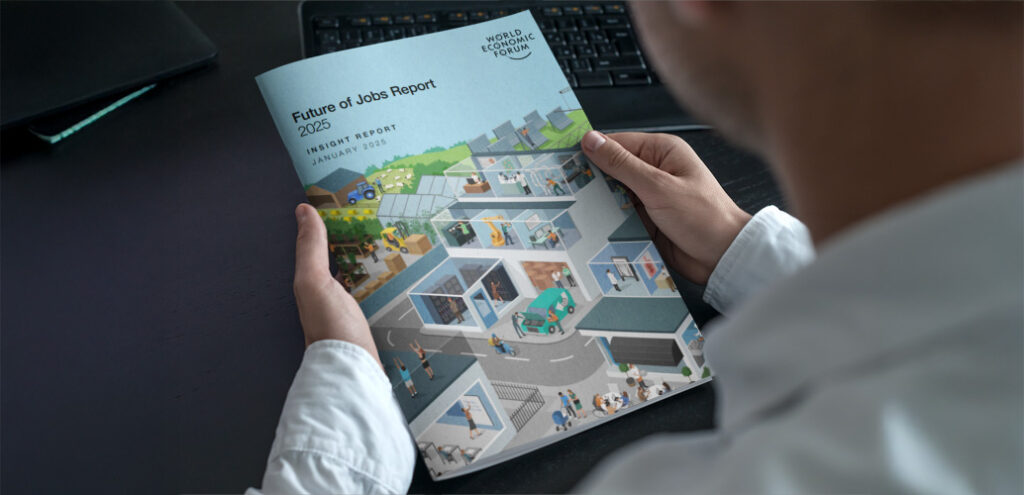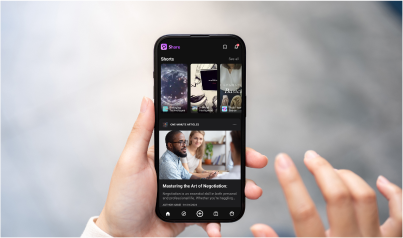The article explores the growth of the e-learning market and highlights Bite-Sized Learning as a key strategy in corporate training. It explains the differences between Bite-Sized Learning and Microlearning and outlines seven effective ways to implement this approach in a business environment.
Finally, it provides a practical guide on how to apply this methodology efficiently within an organisation.
The e-learning sector continues its rapid expansion. In 2024, the industry reached a market value of $314 billion, according to E-learning Global Market Report 2025 by The Business Research Company. Projections indicate a further 13% growth this year, bringing the total to $354 billion. While post-Covid-19 digitalisation has played a significant role in this growth, another key factor is accelerating the shift: Generation Z’s entry into the workforce..
By 2025, Generation Z will represent 27% of the global workforce, reshaping corporate learning strategies. The ‘Future of Jobs Report 2025 highlights that this generation prefers bite-sized, interactive content accessible via mobile devices.

This has led to the rise of Bite-Sized Learning, a format that has established itself as the ideal solution to capture attention, enhance engagement, and improve knowledge retention.
Bite-Sized Learning vs. Microlearning: Are They the Same?
Bite-Sized Learning and Microlearning are often used interchangeably, but they have distinct approaches in corporate training.
- Bite-Sized Learning is a structured methodology designed to break down training into small, organised modules within a long-term learning strategy. Each module has a specific learning objective and follows principles such as spaced repetition and adaptive learning, which enhance knowledge retention. It is typically used in ongoing training programmes where learners progress in a sequential and systematic way, ensuring a structured learning experience.
- Microlearning, on the other hand, focuses on delivering short, standalone content without necessarily being part of a structured learning plan. It is more flexible and can be used independently within or outside a formal training programme. Its primary aim is to provide actionable information at the point of need, without requiring a predefined learning sequence. This makes it ideal for quick reference and just-in-time learning.
The key difference lies in the structure and purpose of each approach. Bite-Sized Learning follows a structured, long-term training plan, whereas Microlearning enables on-demand access to knowledge without a fixed sequence. Both approaches can complement each other to optimise corporate training and enhance knowledge accessibility.
7 Ways to Implement Bite-Sized Learning

1. Microvideos for Quick Training
Short videos are one of the most effective Bite-Sized Learning strategies. Employees can spend just a few minutes accessing key information, facilitating knowledge retention without cognitive overload.
The dynamic and visual nature of videos makes them highly engaging and improves retention. This format is particularly useful for technical training, new digital tools, or quick updates on company policies.
Microvideos can also include interactive elements such as questions or links to additional resources, reinforcing learning effectively.

2. Micro-Assessments and Interactive Quizzes
Short quizzes are an excellent way to track learning progress and reinforce acquired knowledge. By using interactive assessments, employees can self-evaluate and receive immediate feedback, helping them identify areas for improvement.
These quizzes can be embedded at the end of each training module to ensure comprehension, promoting active learning. Additionally, micro-assessments allow organisations to collect performance data, enabling them to optimise training programmes based on real insights.

3. Infographics and Visual Guides
Infographics are a key resource in Bite-Sized Learning, presenting complex information in an easy-to-digest, visually appealing format. They are particularly useful for explaining technical concepts, business processes, or compliance procedures, offering quick access to essential information.
Providing employees with interactive infographics allows them to explore different sections based on their specific needs, resulting in a more personalised and effective learning experience.

4. Podcasts and Audioclips for On-the-Go Learning
Podcasts and audio clips offer a flexible alternative for corporate learning, enabling employees to access educational content while commuting or engaging in other activities. This format is especially beneficial for developing soft skills, such as leadership and communication, as well as for sharing strategic insights within the company.
Featuring industry experts or company leaders in these podcasts enhances their impact, providing employees with valuable perspectives on trends and best practices.
5. Simulations and Interactive Scenarios
Simulations create controlled environments where employees can apply their knowledge to real-life situations without risk. In customer service or crisis management, this approach is particularly valuable, allowing employees to make decisions and experience the consequences in real time.
Implementing simulations enhances practical skills and improves decision-making capabilities, ensuring employees are better prepared for real-world challenges.


6. Digital Flashcards to Reinforce Learning
Digital flashcards are a highly effective tool for reinforcing memory and helping employees retain key concepts. These interactive cards can assist in memorising technical terms, compliance regulations, software shortcuts, or other relevant corporate training content.
Their repetitive and accessible format supports progressive learning, enabling employees to review critical information quickly and efficiently.

7. Gamificación y desafíos de aprendizaje
Gamification transforms corporate training into a dynamic and engaging experience. Through challenges, leaderboards, and rewards, employees can compete in a friendly way while acquiring new skills.
This approach boosts engagement and knowledge retention, making corporate training more interactive and enjoyable.
By incorporating game-like elements, organisations can encourage participation and motivate employees to complete training modules and apply their learning in the workplace.
Conclusion
Bite-Sized Learning is an effective strategy for optimising corporate training, improving knowledge retention, and making learning more accessible and dynamic. When implemented in a structured way, it allows employees to develop key skills without disrupting their workflow.
Would you like to implement Bite-Sized Learning in your company with a flexible, scalable, AI-powered solution? Request a demo of Netex Cloud and discover how to get the most out of your corporate training.

